By Jessica Stoffers | Senior Experiential Graphic Designer
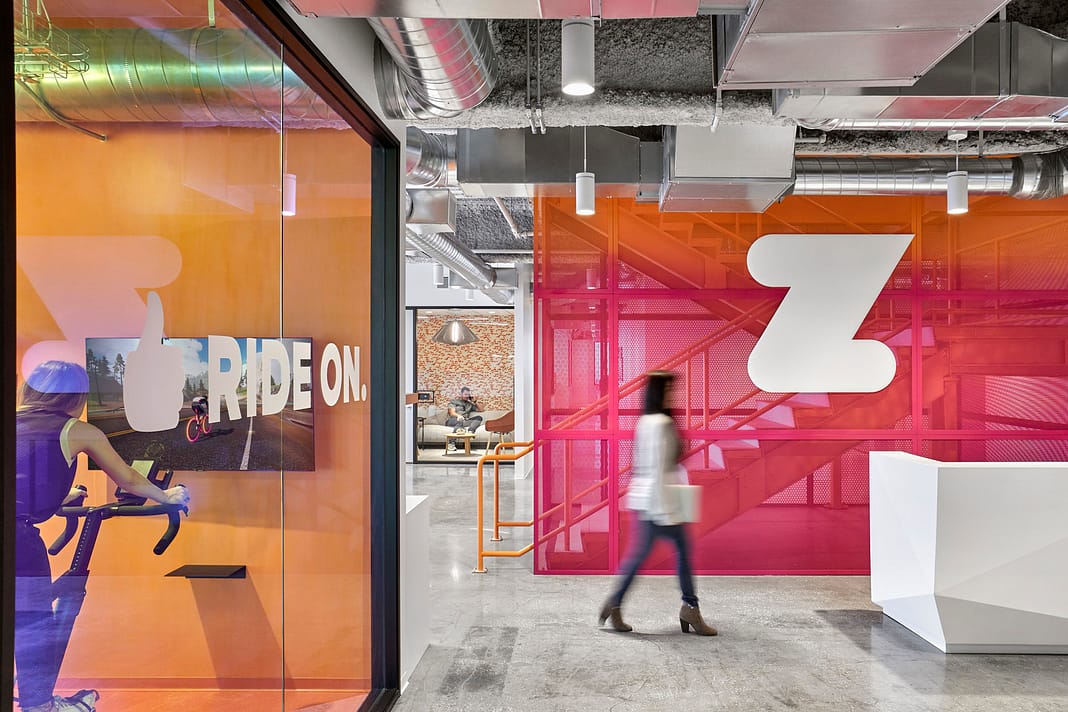
Photography © Garrett Rowland.
Brand guidelines play an important role to ensure organizations build and maintain a consistent brand message and persona internally and externally. Guidelines can be as simple as defining the specifications and use of a logo or as developed as a comprehensive document outlining brand messaging, color palette, typography, photographic styles, and marketing dos and don’ts. But even with strong brand guidelines, organizations often overlook the opportunity to establish brand standards for the workplace, thereby missing the opportunity to create a consistent on-brand ambiance to build culture and inspire staff, clients, and visitors. However, there is a remedy for that.
Experiential design guidelines help clients maintain and communicate a consistent brand identity across architecture and interior design. To that end, IA frequently works with clients to develop guidelines with the flexibility and scalability to establish organizational standards that can be rolled out at a national or global level. The process generally includes guiding clients through an integrated process to gain an understanding of how the organization works, and then creating a tool kit of graphic assets and wayfinding elements that ensure a strong, consistent workplace identity and a compelling brand experience across diverse locations. A unified approach to brand in the workplace builds employee engagement, inspires loyalty and participation in the organization’s culture, and aids retention and recruiting.
Key benefits of guidelines include:
- Clear and consistent parameters as a framework for the design of space
- An easy-to-use kit of parts that streamlines space delivery
- An enlivened brand persona and brand presence across the enterprise
- Ease of consistent space delivery and budget control
- Enhanced communications
Case In Point: Confidential Insurance Client
In Philadelphia, the IA studio recently collaborated with a confidential insurance company client to develop global experiential branding principles for the workplace. With offices across 54 countries, branding had been limited to signage and the use of brand colors as painted accents throughout their locations. Although some offices emphasized this approach more than others, the inconsistency between offices was a missed opportunity to enhance firm-wide connection, build culture, and nurture inclusivity on a global level. Collaborating with the client, IA determined varying levels of brand application that were scalable and flexible for different project and budget types from local branches to regional offices to headquarters. The IA team performed a full portfolio assessment of the offices across the US, South America, and Europe, along with an in-depth brand audit of existing brand standards.
To create the quality of experience anticipated, IA simplified and re-defined space types within public and employee areas and moved towards an activity-based environment. The theme crafted movement inspired and drove the effort, ensuring a dynamic, collaborative, and inclusive brand experience that emphasizes community and wellness at the workplace. The unique storylines of global customers and employee connections were woven together and unfold as users move through the welcome, gather, and workspaces, creating memorable moments.
Once the user journey was mapped to determine the ideal brand experience, a kit of parts was developed. This approach was key to providing a consistent, flexible, and on-brand solution regardless of office location. As a resource, the kit of parts brought together all environmental brand assets, including visual details and explanations about where and how to use branding in the workspace.
For those planning and implementing workplace projects, these experiential brand guidelines are a valuable resource. Providing the design team with the guidelines for review at the kick-off of a project enables them to form a clear understanding of the brand and how to navigate a brand solution for any given project based on criteria and cost savings, while allowing for a more holistic and integrated design approach. Users can express regional and global diversity by selecting assets from the kit of parts that are locally relevant to each project. As our partnership with this client grows, IA continues to test the kit of parts against current projects and discover opportunities for expanding and evolving the guidelines.





Confidential Health Insurance Company
IA’s relationship with this American health insurance company has grown from implementation partner to design partner to developing a comprehensive refresh of brand guidelines. Following collaboration on several projects, the company engaged IA to set guidelines in place for future projects. IA collaborated with the client’s brand team and focus groups to develop a deep understanding of the organization’s public-facing and internal-facing spaces at the workplace. This defined the foundation of a brand strategy deployed across the entire headquarters campus and numerous regional offices around the United States. The year-long effort resulted in an ambitious catalogue of brand and signage elements aligned with in-depth strategies for how and why to apply the design kit of parts.
As clients evolve, so do their cultures and brands. To maintain global consistency and flexibility, guidelines, be they brand or experiential, must be responsive documents that can be updated to reflect change. This client reviews their brand guidelines on a quarterly basis to incorporate updates and additions as project rollouts inform design.
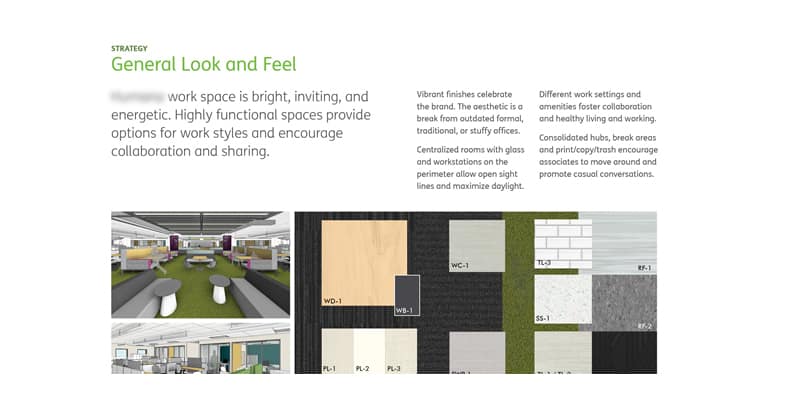
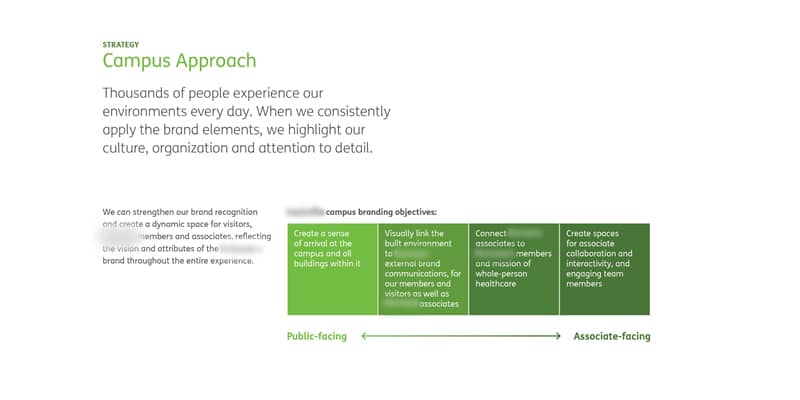
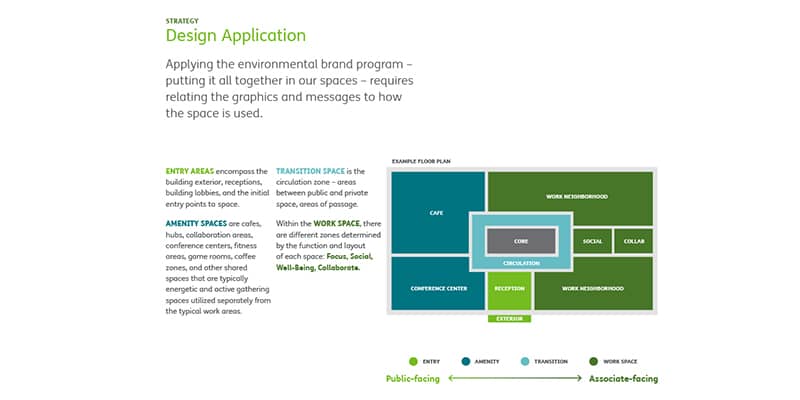
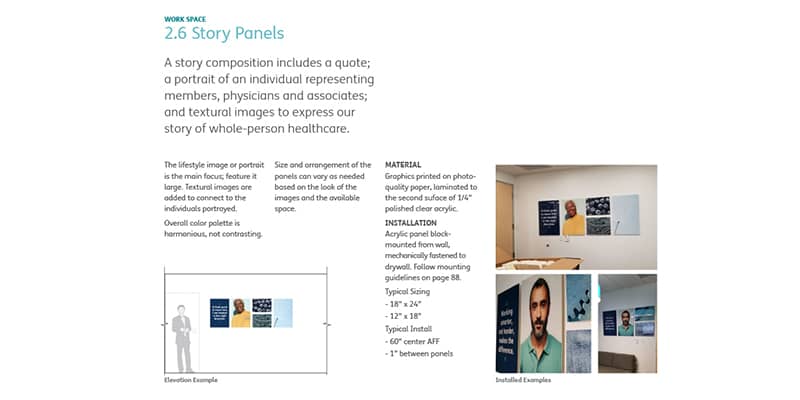
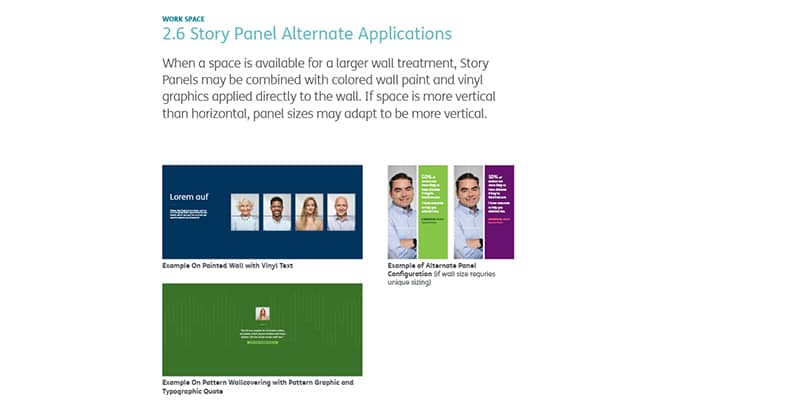
Connecting Brand Expression and Workplace Strategy
Workplace strategy establishes the framework that forms the vision, principles, and approach to the user experience for optimized business performance and to foster employee culture and celebrate brand. Although strategy typically touches on integrating brand expression into the design, it does not define what that will actually look like. Sometimes, strategy and environmental graphics are not in concert, with graphics becoming almost an afterthought. But integrating strategy, environmental design, and brand development at the beginning of a design project, as well as engaging end-users early, is critical and leads to support and consensus during implementation. However, clients going through a rebranding process often wait until launch to release the new brand to architects and designers. Closing that gap to enable clients, workplace strategists, branding agents, and designers to fully consider environmental graphics when developing a design concept or refreshing guidelines saves time, money, and will result in a truly immersive brand experience.

Photography © Garrett Rowland.
Conclusion
The advantages of guidelines are multiple. Environmental design guidelines ensure the continuity of a brand’s definition, story, and spirit as an integral expression of the physical workplace, conveying the brand’s persona to users through an immersive environment on a daily basis that is aligned with company goals and financial planning. Building brand through ambiance gives life and substance to the brand experience and nurtures a strong organizational culture and human experience.

